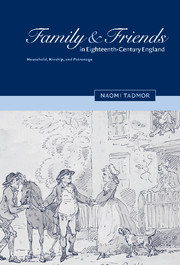Book contents
- Frontmatter
- Contents
- Acknowledgements
- A note on the text
- List of abbreviations
- Introduction
- 1 The concept of the household-family
- 2 The concept of the household-family in novels and conduct treatises
- 3 The concept of the lineage-family
- 4 The language of kinship
- 5 Friends
- 6 Political friends
- 7 Ideas about friendship and the constructions of friendship in literary texts
- Conclusion
- Bibliography
- Index
5 - Friends
Published online by Cambridge University Press: 30 July 2009
- Frontmatter
- Contents
- Acknowledgements
- A note on the text
- List of abbreviations
- Introduction
- 1 The concept of the household-family
- 2 The concept of the household-family in novels and conduct treatises
- 3 The concept of the lineage-family
- 4 The language of kinship
- 5 Friends
- 6 Political friends
- 7 Ideas about friendship and the constructions of friendship in literary texts
- Conclusion
- Bibliography
- Index
Summary
Introduction
In the eighteenth century, the term ‘friend’ had a plurality of meanings that spanned kinship ties, sentimental relationships, economic ties, occupational connections, intellectual and spiritual attachments, sociable networks, and political alliances. In this chapter, we shall investigate a spectrum of relationships designated in the eighteenth century as ‘friendship’.
Today the word ‘friend’ is not applied ordinarily to designate familial relationships, but in the seventeenth and eighteenth centuries usages of ‘friend’ to designate kin were extremely common. At the same time, however, ‘friend’ was used to refer to a wide range of non-related supporters, such as patrons, guardians, employers, and other allies. In addition, ‘friend’ was used to describe well-wishers, companions, members of social circles, or select friends – as it does today. Ralph Josselin, for example, used the word ‘friend’ to refer to a wide range of kin, from his sisters, brothers-in-law, uncles, and cousins, to his wife's relations. About a century and a half later, Miss Weeton still described the travails of women who married without the consent of their ‘friends’, namely, their relations. In contrast, Samuel Pepys used the word ‘friend’ to designate a non-related patron, as he rushed to the death-bed of one Mr Pierce to promise him that he would ‘be a friend’ to his wife and family. The rector Benjamin Rogers also named his non-related patron, who had found him employment, as ‘the best friend I ever had’.
- Type
- Chapter
- Information
- Family and Friends in Eighteenth-Century EnglandHousehold, Kinship and Patronage, pp. 167 - 215Publisher: Cambridge University PressPrint publication year: 2001
- 2
- Cited by

